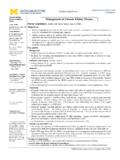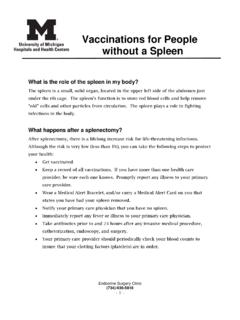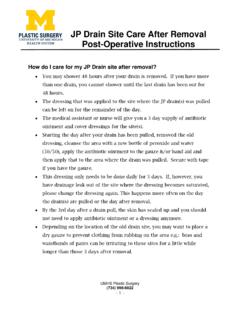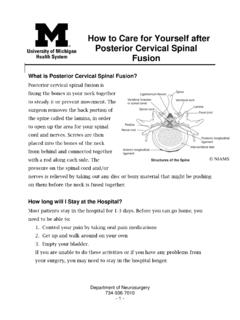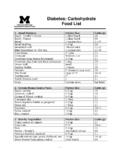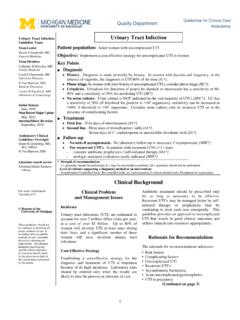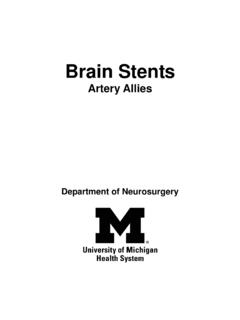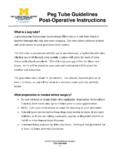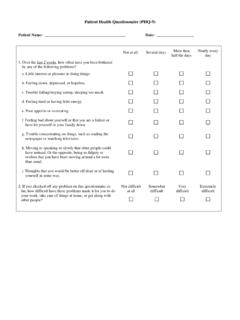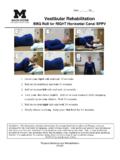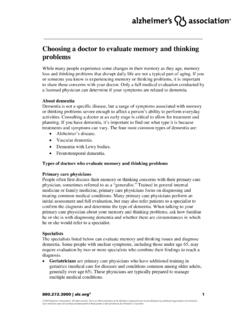Transcription of GERIATRIC FUNCTIONAL ASSESSMENT
1 GERIATRIC FUNCTIONALASSESSMENTAn educational exercise with a Standardized Patient Instructor emphasizing functionalstatus ASSESSMENT and communication skills relevant to the care of older patients. Division of GERIATRIC MedicineDepartment of Internal Medicine2003 Students:Please review this material carefully prior to the exercise and bring yourTools for GERIATRIC Care pocket TO THE 3RD FLOOR LOBBY OFTAUBMAN MEDICAL LIBRARY (LRC)TABLE OF CONTENTSI ntroduction 1 Goals and Intended Learning Outcomes 2 Guidelines for Standardized Patient Interview 3 Instructional materials:Assessing Patients FUNCTIONAL Status 4 Screening for Cognitive impairment 5 Screening for Depression 7 Evaluating Patients with Gait Instability or Falls 9 Communicating with Older Patients11 ASSESSMENT tools: FUNCTIONAL impairment ADLs, IADLs13 Gait instability/risk for fallsTimed Up and Go Test13 Cognitive ImpairmentMini-Cog14 Major Depressive Illness2-question Screener14 Reference List15 Tools for GERIATRIC Care pocket card attached1 INTRODUCTIONAll physicians who care for adults are caring for an increasingly large number ofolder patients.
2 Older patients are more likely than younger patients to haveunrecognized comorbidities and impairments that increase their risk of medicalmorbidity, FUNCTIONAL decline, and mortality. Often, older patients' comorbidities areunrecognized by health care professionals since they may not be the primary focus ofclinical encounters, and are unrecognized or not mentioned by the patients impairments and cognitive and affective problems are particularlyprevalent among older patients, and can be improved with early recognition who care for older adults should be able to recognize FUNCTIONAL ,cognitive, and affective impairment among their patients to enable appropriatemanagement or referral. Information and tools are now available for all physicians torapidly and accurately identify clinically important impairments among older brief ASSESSMENT of older patients requires effective use of a broadrange medical interviewing skills.
3 Application of a few simple interviewing techniqueswill substantially enhance the amount and accuracy of information obtained in speakingwith older AND INTENDED LEARNING OUTCOMESG oalsThe goals of this Standardized Patient Instructor (SPI) exercise are to enable studentsto develop their skills in:1. Accurately assessing the FUNCTIONAL , cognitive, and affective status of olderpatients, and2. Effectively communicating with older is a learning exercise, not a formal evaluation exercise. Learners will be givenimmediate feedback on their performance, with specific tips for Learning OutcomesSpecifically, by the end of the exercise the learner should be able to:1. Ask a brief series of questions to identify impairments in Basic Activities of DailyLiving and Instrumental Activities of Daily Living (including medication use).2. Ask about the presence or absence of Screen patients for gait impairment and fall risk using the Timed Up and Go Screen patients for cognitive impairment by administering and interpreting the Mini-Cog Screen patients for major depressive illness using a two-question Use appropriate interviewing techniques to facilitate communication with Demonstrate respect for older FOR THESTANDARDIZED PATIENT INSTRUCTOR INTERVIEWCase scenarioYou are rotating on a busy inpatient service.
4 It is 10:00 AM and you have completed morningwork rounds on the 15 inpatients on your service. You have the next hour to do most of theday's work ( , schedule diagnostic tests for your patients, prepare for teaching or workrounds, write the daily orders for your patients).Mr. or Ms. Gerhard is an 85-year-old patient who is to be discharged that morning. Dischargeorders were written last night, and the patient looked fine when you saw him/her during yourmorning work rounds. The patient reported that they were ready to go. However, a floornurse has just informed you that Gerhard s daughter just called to say they cannot shecan not the patient home. She didn't get many details, but reports that the patient's daughtersaid that she "couldn't handle him/her" and that the patient would be too much to take careof at home. The daughter is on jury duty and will not be available for you to call her until goal during this patient encounter is to learn what problems Gerhard might havein functioning well at home.
5 You set aside what you re doing and enter the GuidelinesYou will have 30 minutes to interview the patient. Gerhard will be seated in the examroom, dressed and "ready to go. Begin the interview with a statement like "Hello, I understand you re planning to go home. I need to review some things with youbefore your discharge." Your next questions should be directed to assessing physical functionand the patient s capacities at home just prior to hospital the interview, you will be expected to appropriately screen for impairments in: Activities of Daily Living Instrumental Activities of Daily Living Gait impairment (Timed Up and Go) Cognition (Mini-Cog) Affect (Depression) (Two-Question Screener)During the interview you are encouraged to use the Tools for GERIATRIC Care pocket card, whichcontains information on screening for many of these you feel you have collected the information needed for this ASSESSMENT , you will close theinterview by stating Thank you for answering these questions.
6 I will discuss this informationwith the attending physician and we will return shortly. After the interview is completed, the patient will provide feedback on your Patients FUNCTIONAL StatusDefinition: FUNCTIONAL impairment is defined as difficulty performing, or requiring theassistance of another person to perform, one or more of the following Activities of DailyLiving (ADL):Activitiesof Daily Living (ADLs)*Instrumental Activitiesof Daily Living (IADLs)**BathingAdministering own medicationDressingGrocery shoppingToiletingPreparing mealsTransfersUsing the telephoneGroomingDriving and transportationFeedingHandling own financesHousekeepingLaundry Note: italicized items are most important*ADLs are the essential elements of self-care. Inability to independently perform even oneactivity may indicate a need for supportive services.
7 **IADLs are associated with independent living in the community and provide a basis forconsidering the type of services necessary in maintaining :Approximately 75% of persons over age 75 limit their activities due to FUNCTIONAL impairmenteach year; 40% experience restricted activity in two consecutive months. Almost 50% ofpeople 85 years of age and older require assistance in one or more ADL. As many as 25% ofolder community-dwelling adults have at least one impairment in patient admitted to general medical hospital units, 40% have at least one ADLimpairment, 65% have one or more IADL impairments, and 30% have mobility implications: ADL impairment is a stronger predictor of hospital outcomes ( FUNCTIONAL decline, length of stay,institutionalization, and death) than admitting diagnoses, Diagnosis Related Group, and otherphysiologic indices of illness burden.
8 ADL impairment is also a risk factor for nursing homeplacement, emergency room visits, and death among community-dwelling 25% to 35% of older patients admitted to the hospital for treatment of acutemedical illness lose independence in one or more ADL. Risk factors for loss of independence inADLs during hospitalization include advanced age, cognitive impairment , and IADL impairmentsat for Cognitive ImpairmentPrevalence:The prevalence of clinically significant cognitive impairment is roughly 3% amongpersons 65 years of age or older, and doubles in prevalence every 5 years reaching 40-50% among persons 90 years of age or older. Most patients with dementia do notcomplain of memory loss or even volunteer symptoms of cognitive impairment unlessspecifically implications:Many elderly patients seen by surgical and medical specialists and subspecialists havesignificant cognitive impairment , often undiagnosed.
9 Unrecognized cognitiveimpairment is a risk factor for medication non-adherence, poor compliance withbehavioral recommendations, difficulty navigating the health care system, and caregiverstress. The most common causes of cognitive impairment in elderly patients aredementia, depression, and :Patients with suspected cognitive impairment should be screened for delirium anddepression. Delirium is a disorder of attention, and should be considered in patientswith waxing and waning attention or level of consciousness. Delirium is commonly aside effect of medications, and often unrecognized by is suggested by the presence of cognitive impairment with: Acute onset (hours to days) and fluctuating course Inattention (difficulty maintaining focus). Disorganized thinking OR Altered level of consciousnessScreening for depression is discussed below ( Screening for depression ).
10 To diagnose dementia, a thorough history and physical examination assist in thediagnosis of dementia and the cause of evidence exists, however, that several rapid screening tests somerequiring less than a minute to administer can be used to rule out dementia:Screening test Negative Likelihood RatioMini-Cog< State Examination (MMSE)Score >= recall at one 7 Drawing applications:The brief screening tools described above can be used in a matter of a few minutes tosubstantially rule out cognitive impairment due to : An 80-year old patient whom you are seeing in follow-up aftersurgery, reports that he has not taken his medications as prescribed. You findthat he is able to perform the 3-item recall or serial 7 s. You can conclude thatthe probability of cognitive impairment in this patient is <5%, and other causesof poor medication adherence must be sought.
